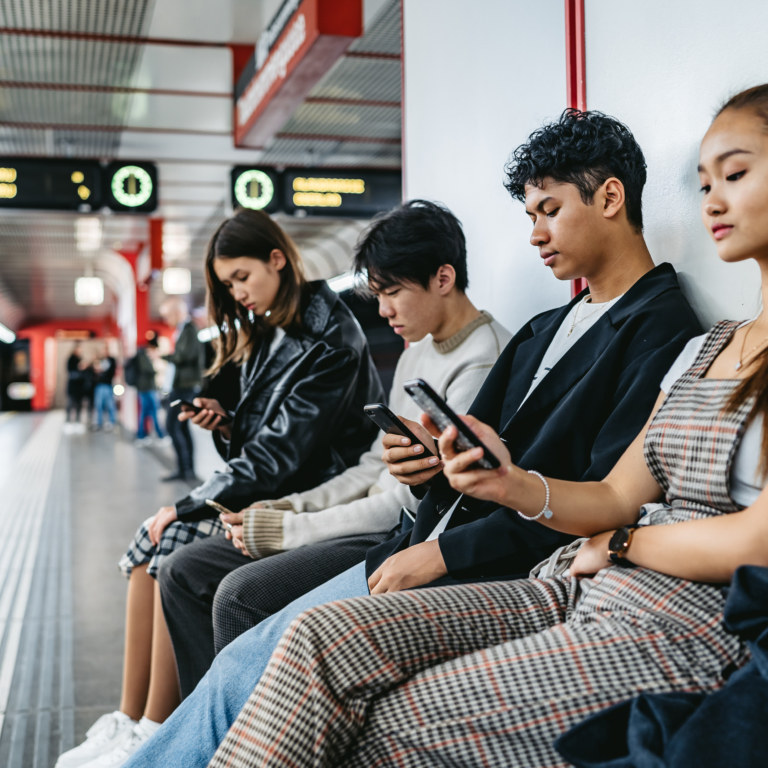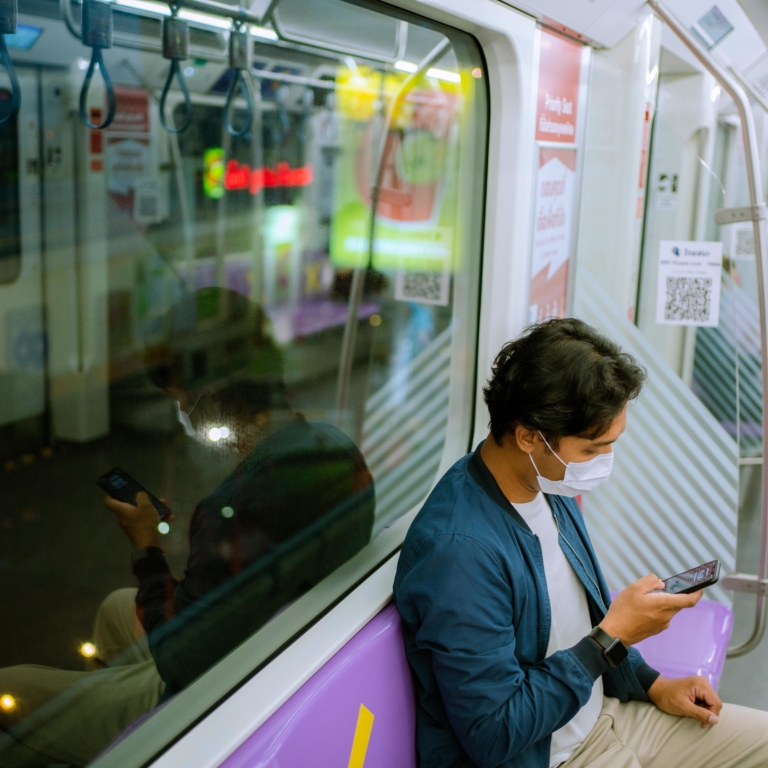5G Transformation Hub
How high-capacity 5G could transform subway travel
As 5G technology advances, the network throughput could improve from 3-4 Gbps to 5-6 Gbps.
South Korea’s Ministry of Science and ICT (MSIT) is looking to dramatically improve the Wi-Fi available on Seoul’s subway trains by using high capacity 5G networks to connect access points to the Internet. By harnessing 5G networks operating in high-frequency millimetre wave (mmWave) spectrum, MSIT expects to enable subway passengers to watch videos in 4K resolution on their mobile devices – something that isn’t possible with the in-train Wi-Fi coverage today.
Select a project
Contents
Challenge
Although Seoul’s subway network is covered by LTE and 5G networks in the 3.5GHz band, these services don’t have sufficient bandwidth to support high-speed Wi-Fi services for scores of passengers simultaneously. Backhauled by LTE, the average Wi-Fi speed on subway trains in Seoul was 71 Mbps in 2020. If 100 passengers in a carriage were to try and access the Wi-Fi simultaneously, each traveller would only be able to connect at speeds of less than 1 Mbps.
Solution
A trial on the Seongsu Branch of Seoul subway line 2, found that 5G millimetre wave (mmWave) backhaul can boost public Wi-Fi speeds by up to 25 times. Now the MSIT is working with Korea’s mobile operators to provide 5G mmWave coverage across subway lines 2, 5, 6, 7 and 8. The MSIT believes the 5G network should support at least 700 Mbps in each car, increasing passenger mobile broadband capacity 10-fold.
Impact & Statistics
Harnessing 5G mmWave services should dramatically improve connectivity in locations where millions of Koreans spend a significant part of their day: Five million people use the Seoul subway daily and about 90% of them have smartphones. Seoul City data suggests the average passenger spends 35.9 minutes per day on the subway.
Wider Implications
By enabling subway users to enjoy 4K videos, the 5G mmWave connectivity will enhance their quality of life and, in some cases, their productivity. It could also encourage greater use of public transport, reducing vehicle congestion, pollution and greenhouse gas emissions in Korea’s cities. If 5G mmWave successfully supports Wi-Fi on subways, it could also be the ideal solution to bring connectivity to other busy areas, such as airports, festivals, sports stadiums or shopping centres.
Stakeholders
The Ministry of Science and ICT, mobile operators, Qualcomm
02
How high-capacity 5G could transform subway travel
As 5G technology advances, the network throughput could improve from 3-4 Gbps to 5-6 Gbps.
Sourcing enough bandwidth to deliver reliable high-speed connectivity to passengers travelling on busy trains and buses can be difficult. New high capacity 5G networks operating in mmWave spectrum could be the answer.
South Korea’s Ministry of Science and ICT (MSIT) is looking to dramatically improve the Wi-Fi available on Seoul’s subway trains by using mmWave 5G networks to connect access points to the Internet. MSIT believes this solution will enable subway passengers to watch videos in 4K resolution on their mobile devices – something that isn’t possible with the in-train Wi-Fi coverage today. The existing Wi-Fi service can support less than 1 Mbps passenger at busy times, curbing usage.
High-capacity Wi-Fi could make travelling by subway more appealing, potentially reducing vehicle usage, congestion, greenhouse gas emissions and pollution in South Korea’s cities. In fact, public transport is one of the most promising deployment cases for 5G connectivity. Urban buses and trains generally condense large numbers of people into small spaces for significant periods of the day. That makes public transport a good fit with mmWave 5G, which supports much higher capacity, but a much smaller range, than mid-band or low-band 5G.
Following a proof of concept in 2021, South Korea’s three main mobile operators- KT Corp., SK Telecom, and LG U+ - plan to install mmWave 5G across Seoul subway lines 2, 5, 6, 7 and 8, which have more underground sections than the other lines. These underground lines are well placed to harness a key radio characteristic of millimetre waves, which travel further through tunnels than in the open air. “The radio characteristics of the tunnel create a beneficial wave guide effect, which improves the radio propagation in that space, so we are leveraging that benefit,” explains the MSIT official in charge.
In the proof of concept, mmWave 5G connectivity delivered an average aggregate bandwidth of 700 Mbps to Wi-Fi users inside the subway cars. The trial employed 800MHz in the 5G backhaul.
The operators plan to complete the installation of new dedicated base stations during 2022, with services starting at the end of the year. According to Seoul Metro, there are 2,443 subway carriages (cars) running on Seoul subway lines 2, 5, 6, 7, and 8.

03
Providing high-speed Wi-Fi to large numbers of passengers
Although many public transport services provide passengers with Wi-Fi, the quality of the connectivity can be well below what Koreans are accustomed to in their homes and workplaces. That’s because the density of passengers can mean the networks become very congested, particularly during peak commuting periods.
Featuring 10 subway lines, the Seoul metropolitan subway in South Korea is one of the most widely used rapid railway transport systems in the world. It serves nearly ten million inhabitants of the capital city, Seoul, and the provinces of Gyeonggi, Incheon and northern Chungnam.
Although the city’s subway network is covered by LTE and 5G networks in the 3.5GHz band, these services don’t have sufficient bandwidth to support high-speed Wi-Fi services in the carriages. Backhauled by LTE, the average Wi-Fi speed on subway trains in Seoul was 71.05 Mbps in 2020, far lower than subway stations, where the average speed was 367.24 Mbps, according to a report1 by the Korea Biz Wire. If 100 passengers in a carriage were to try and access the Wi-Fi simultaneously, each traveller would only be able to connect at speeds of less than 1 Mbps. That throughput is far below the performance levels available elsewhere in South Korea. “We don’t have figures for how much Wi-Fi is used on the subway today, but the slow data rate means we don’t think all of the passengers use it,” says the MSIT official. “The customer expects 4K video, but the connectivity today isn’t good enough to support that.”

Sources
- 1. http://koreabizwire.com/5g-based-wi-fi-service-coming-to-some-seoul-subway-lines/200374
04
Millimetre wave 5G delivers step change in capacity
In September, the MSIT, together with Samsung and the three major mobile operators, tested 5G running in the 28 GHz band to deliver Wi-Fi at Sindap Station in Seoul. On the Seongsu Branch of Seoul Subway Line 2, the three telcos installed 28 GHz 5G equipment that can support data transmission speed of up to 20 Gbps.
For the trial, Samsung equipped five stations with 26 gNodeB’s (gNB s) – mmWave compact macro units (which combine a baseband unit, radio and antenna in a single lightweight form factor). Five trains were equipped with customer premise equipment (CPE s) from Hucom Wireless and 20 Wi-Fi access points from Linksys. Each train had 2 CPE s installed at the engine room in front and rear car, while an access point was installed in each of the four passenger cars in each train.
Samsung reported2 that the mmWave 5G connectivity backhaul boosted public Wi-Fi speeds by as much as 25 times. It said users benefitted from Wi-Fi download speeds of 1.8 Gbps on a “fast-moving subway train” underground.
Following the successful trial, MSIT’s ultimate ambition is to bring 5G mmWave connectivity to all of Seoul’s subway lines. In the first phase, subway lines 2, 5, 6, 7 and 8 will be covered by a shared non standalone (NSA) 5G network built by the three mobile operators. The operators will divide the network construction between them, with each carrier taking responsibility for a different line. The cost of the project hasn’t been made public to respect commercial confidentiality.
If the resulting Wi-Fi service is able to support at least 700 Mbps in each car, 100 passengers could each simultaneously have a 7 Mbps connection. “We have been using CPE designed for a fixed environment,” says the MSIT official. “When we move to the mobile version, we expect to see further improvements. The actual bandwidth coming through the 5G backhaul is 3-4 Gbps.”
In the pilot, the use of a NSA 5G network resulted in some handover issues between base stations and the LTE radio network had to be employed as a fall back. However, SK Telecom has been able to address these issues by changing some of the network parameters.
The Wi-Fi connectivity itself is also set to improve. Once the service deploys Wi-Fi 6E, the latest Wi-Fi standard, the available bandwidth could improve further. Wi-Fi 6E can make use of more channels – each carrier will be able to use three channels of 160 MHz - which will mean a major improvement inside the train, says the MSIT official. “That will create a virtuous circle – as the service improves, more people will use it.”

Sources
- 2. https://news.samsung.com/global/samsung-utilizes-5g-mmwave-to-boost-wi-fi-connections-in-subways
05
Commuting by subway to become more enjoyable
Harnessing 5G mmWave services should dramatically improve connectivity in locations where millions of Koreans spend a significant part of their day. By enabling them to enjoy 4K videos, the service will enhance their quality of life and, in some cases, their productivity. It could also encourage greater use of the subway, reducing vehicle congestion, pollution and greenhouse gas emissions in Korea’s cities.
When a passenger connects to the in-train Wi-Fi, they will need to authenticate themselves with their mobile operator for security reasons. Once compatible smartphones become available, subway passengers may be able to connect to the network directly, rather than via Wi-Fi. For South Korea’s mobile operators, the 5G mmWave network will improve their overall service proposition to their customers, which may enable them to generate additional revenues.
If 2.5 million passengers were to spend an average of 20 minutes a day on the new Wi-Fi service, they could collectively consume around 2.6 million gigabytes of data per day. At a notional value of a US$1 per gigabyte, the 5G-enabled connectivity would be generating US$2.6 million of value a day.
“Five million people use the subway daily and 90% of them have smartphones, so there is strong demand,” says the MSIT official. “Once we meet customers’ expectations for a full video stream, we think usage will increase substantially.”
Data published by Seoul City suggests the average passenger spends 35.9 minutes per day on the subway, travelling an average distance of 13.73 km.
The installation of 5G mmWave connectivity on the Seoul subway will act as a key test case of whether the technology can provide high-speed backhaul for Wi-Fi 6E. If it successfully brings high-speed Wi-Fi to large numbers of subway passengers, it could also be the ideal solution to bring connectivity to other busy areas, such as airports, festivals, sports stadiums or shopping centres, which may also be able to exploit the wave guide effect.
Although the high capacity 5G network will primarily be used for providing passengers with Internet access, it could ultimately take over from LTE-R, which is used by the train operator to relay CC TV pictures from inside the subway cars. These dedicated links are used to monitor passenger safety.

06
More millimetre wave coverage in future
Once the upgrade to the connectivity on the first five lines is completed, the MSIT will consider extending 5G mmWave coverage to the remaining lines. By then it should be feasible to deploy a standalone 5G network, which should further boost performance. Over time, MSIT believes the network throughput will improve from 3-4 Gbps to 5-6 Gbps.
If the deployment in Seoul is successful, other subway systems in South Korea are likely to follow suit. “The subways outside Seoul are operated by different companies and they will be monitoring the progress of this project closely and they will be interested to see the results,” says the MSIT official.
Operators of stadiums, festivals, airports and other facilities catering to large numbers of people will also be watching the Seoul subway deployment closely. For them, 5G mmWave could be the key to bringing robust and reliable high-speed connectivity to their customers.

07
About
About the GSMA
The GSMA is a global organisation unifying the mobile ecosystem to discover, develop and deliver innovation foundational to positive business environments and societal change. Our vision is to unlock the full power of connectivity so that people,
industry, and society thrive. Representing mobile operators and organisations across the mobile ecosystem and adjacent industries, the GSMA delivers for its members across three broad pillars: Connectivity for Good, Industry Services and Solutions, and Outreach. This activity includes advancing policy, tackling today’s biggest societal challenges, underpinning the technology and interoperability that make mobile work, and providing the world’s largest platform to convene the mobile ecosystem at the MWC and M360 series of events.
For more information, please visit the GSMA corporate website at www.gsma.com.
Follow the GSMA on Twitter: @GSMA.
GSMA 5G Transformation Hub
The GSMA 5G Transformation Hub is a source of information on some of the most innovative 5G solutions in the world. This portal contains case studies detailing design, benefits, key players, measured value and the future impact of scaling up these 5G solutions worldwide. The 5G Era is now firmly established and this family of standardised GSM technologies, including mmWave, are being rolled out successfully across the globe. The GSMA 5G Transformation Hub, launched at MWC Barcelona in 2022, provides details of how 5G is best placed to deliver real value for a range of key sectors including manufacturing, energy, transportation, media and live entertainment, smart cities and construction.. Many more case studies will be added, in the coming months, covering even more industries and the GSMA is asking Members to nominate innovative 5G case studies to add to this global digital showcase. The 5G Transformation Hub and this particular Case Study are both sponsored by Qualcomm.
About this case study
This case study is for information only and is provided as is. The GSM Association makes no representations and gives no warranties or undertakings (express or implied) with respect to the study and does not accept any responsibility for , and hereby disclaims any liability for the accuracy or completeness or timeliness of the information contained in this document. Any use of the study is at the users own risk and the user assumes liability for any third party claims associated with such use.